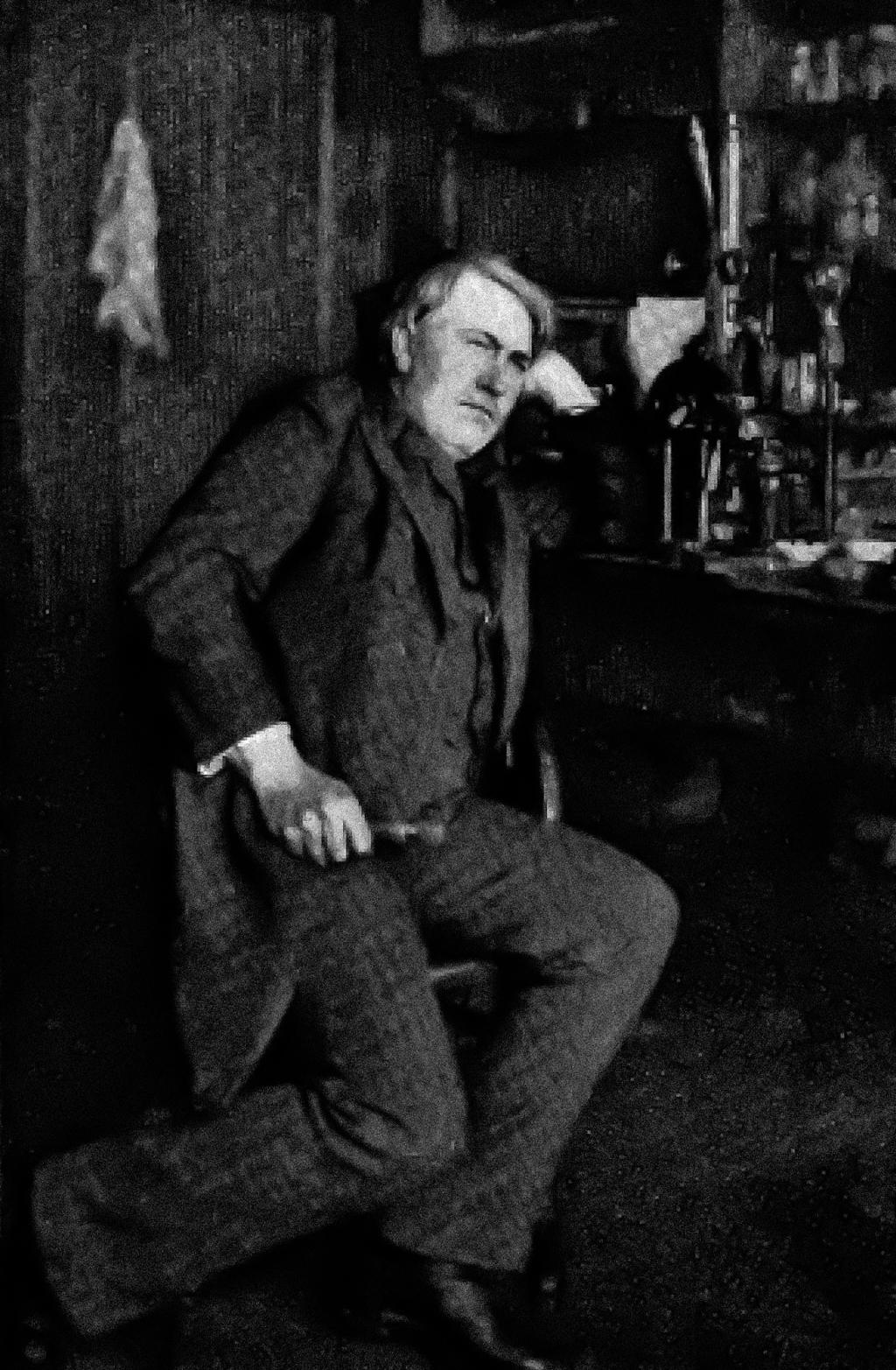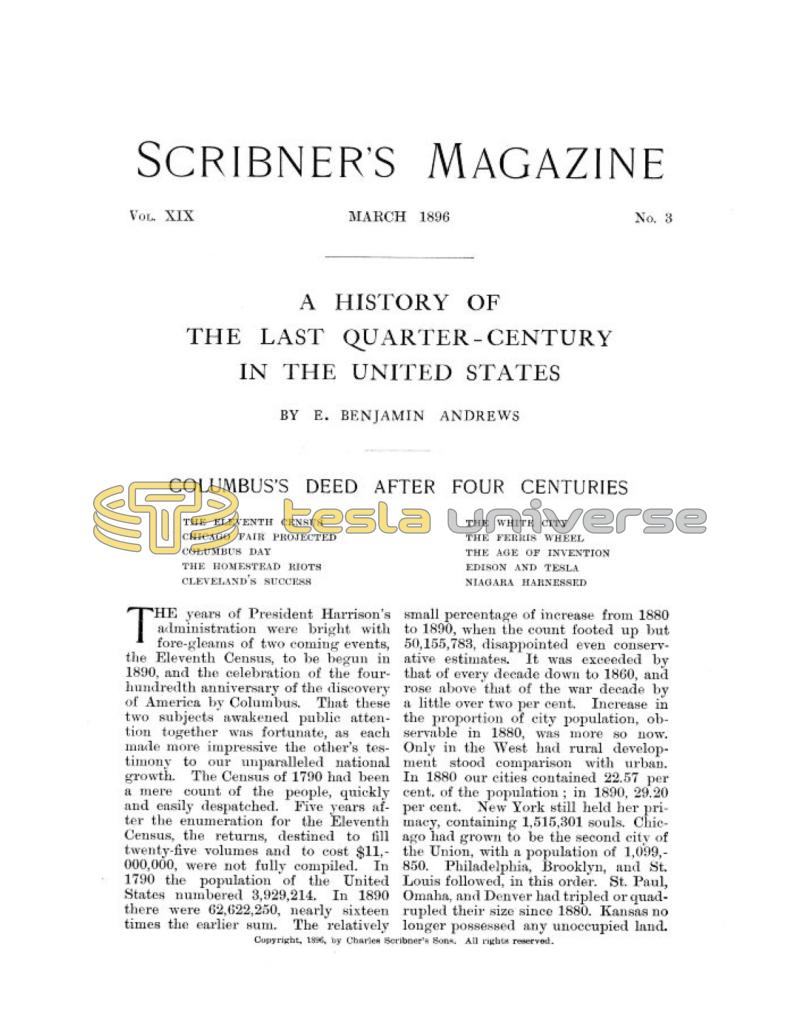
Nikola Tesla Articles
A History of the Last Quarter-Century in the United States
Webmaster note: Unrelated content has been omitted from this article.
The Era of Electricity
What wonder it evoked at the Exposition of 1876, that the Corliss engine with its complex system of belting was able to supply power so far! At Chicago silent wires carried energy to the remotest extremities of the vast grounds. In 1876 the telegraph constituted almost the sole practical application of electricity. Even that invention now owes its chief efficiency to improvements since made, while the new uses of electricity are almost infinitely numerous. Edison prophecies that ere long mankind’s sole work will consist in “pushing the button.” When Morse’s bill for a telegraph line between Washington and Baltimore first reached Congress, he was ridiculed as rain-makers now are. One legislator moved to amend by providing for a line to the moon, the House entertaining the amendment because it entertained the House. Morse, however, got his appropriation. The first day of its public operation that telegraph yielded the Government one cent; in 1890 a single telegraph company had a yearly revenue of nearly $20,000,000. Stearns and Edison have compelled the single wire to carry several messages at once, and that in different directions.
The telephone, the electric light, and the electric motor are the three great fin de siecle inventions. In 1876 Mr. Bell exhibited to the curious an electric transmitter of the human voice, a contrivance on which, after years of experiment, he had stumbled almost simultaneously with other men. Testing the possibility of sending mere sound-waves over a wire, he accidentally found that articulate speech could be so carried. The same year Edison added a carbon transmitter, whereupon the novelty went forth conquering and to conquer. In 1893 the Bell Telephone Company owned 307,748 miles of wire, an amount increased by rival companies’ property to 444,750. There were that year nearly 14,000 “exchanges,” 10,000 employees, 250,000 subscribers, and 2,000,000 daily conversations. This device promises to rival the telegraph, being able to transmit the human voice 1,400 miles. New York and Chicago were placed on speaking terms only three or four days before “Columbus Day.” Telephone service now connects New York, Philadelphia, Boston, Chicago, and other cities each to each, and is already found indispensable. Arc-lamps shown at the Philadelphia Exposition drew sightseers as candles attract moths. They had originated only shortly before, when Charles G. Brush, of Cleveland, O., perfected his dynamo. Men of science still viewed incandescent lighting as an elusive will-o’-the-wisp; but in 1878 Edison, after stupendous labor, mastered the secret and rendered it practically available. At the White City the arc light literally turned night into day. Palaces were radiant with countless incandescent bulbs, while many-colored electric fountains coruscated outside.
In the Centennial year the thought of transmitting power by electricity was considered chimerical. In the Columbian year it was no longer even a novelty, and electricity was far and wide beginning to supplant forms of power familiar before. Street-car traction soon passed to its control, the few horses still in this service coming to be looked upon as curious survivals. Whereas in 1889, out of 8,150 miles of street railway in fifty-eight of the landing American cities, only 260 were operated by electricity, the proportion in the intervening six years has been almost reversed, and the electric car has become an established feature of our civilization. Where a city business man or laborer living in the suburbs formerly required an hour to reach home, the trolley-car now transports him in twenty minutes. A vast addition is thus made to the leisure at men’s disposal for uses which enrich life. Rapid transit blessedly relieves the crowded sections of cities, placing the country with its invigorating air within reach of the poor. Electricity is moving trains upon great railways and bids fair to supplant steam there. The use of it by a few roads proves its perfect availability, and its full employment seems to be postponed solely by disinclination to invest in a given mode for its application when a cheaper and better one may be invented any day. Horseless carriages and pedal-less cycles are clearly in prospect.
Among those deserving the world’s gratitude for harnessing electricity to humanity’s uses, Thomas Alva Edison, “the Wizard of Menlo Park,” is famous - less for absolute originality than for dogged patience and subtle insight enabling him to fructify others’ devices. Thrown upon the world at fifteen, with little book learning but with a wonderful craving for knowledge, he is now among the world’s most famous men. While a newsboy on the Grand Trunk Railway, he found time to road Newton’s “Principia,” to edit and print a small weekly paper, and to conduct experiments. He became a telegraph operator. One of his inventions was an automatic device for answering the central office, when it called, that he was awake, though in fact he was quietly dozing. He also contrived an automatic repeater to transfer messages from one wire to another. Interesting some capitalists in a machine by which votes in legislative bodies could be automatically recorded, he learned that expedition in legislation is what legislators, at least if in the minority, do not desire. His first profitable invention was an improved stock printer, for which he received $40,000. From this time he wrought miracles on notification - useful ones, that have modified men’s life in important regards. Incandescent lighting is familiar to all; the phonograph to most. This instrument was recently employed by a coroner to pronounce a funeral service. He had procured a phonograph for the purpose and gotten a clergyman to utter to it the proper scriptures, hymns, and prayers. When occasion arose for its use the friends gathered for the obsequies were astonished to hear the words, “Blessed are the dead who die in the Lord” sonorously roll forth. Combined with the kinetoscope the phonograph forms the “kineto-phonograph.” Edison declares that the time is near “when grand opera can be given at the Metropolitan Opera House at New York without any material change from the original, and with artists and musicians long dead.”
A more original genius than Edison, veritably a wizard, is his young disciple, Nikola Tesla, who was born in Servia and found employment with Edison on landing in America. For small electric lights he dispenses with the filaments inside the bulbs and makes dilute air do their work. He sends currents of high tension through space, without any conductor, at a voltage many times greater than that employed in electrocution. He receives in his person currents vibrating a million times a second, of two hundred times greater voltage than needed to produce death. He surrounds himself with a halo of electric light and calls purple streams from the soil. His experiments are of the utmost promise to the industrial world. His aim is to hook man’s machinery directly to nature’s, pressing the ether waves directly into our service without the intervention or the generation of heat, in which such an enormous proportion of the energy goes to waste, ninety per cent. in arc lighting, ninety-four in incandescent. By his “rotating magnetic field” and the employment, devised by him, of currents of great frequency and high potential power can be economically transmitted to a much greater distance than hitherto. Tesla’s polyphase motors were adopted for converting into electricity the power of Niagara Falls. In 1873 a canal was opened there with a fall furnishing 6,000 horsepower. Since 1890 another canal has been built, conveying a vast weight of water to the wheel-pit through ten separate channels. This mighty volume of descending water drives three dynamos each equipped with one of Tesla’s 2-phase alternating generators of 5,000 horse-power, developing about 2,000 volts with a frequency of 25 cycles a second. It is thought that the Niagara Falls Power Company can, before very long, furnish Chicago with energy at a cost less than that of steam made on the spot by coal. Presaging this result, electricity created at Laufen, Germany, has been carried to Frankfort with a loss of only four per cent. Electricity created at the falls of the American River at Folsom, Cal., where four turbine water-wheels develop over 5,000 horse-power, has been carried by overhead copper wires to Sacramento, twenty-four miles away, with a loss of not over twenty per cent. At present it propels street-cars, but it is also to be used for lighting streets and operating factories.

